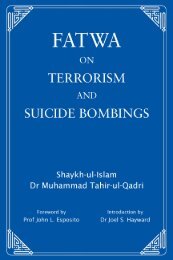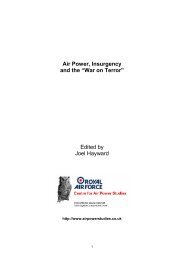Air Power, Insurgency and the âWar on Terrorâ - Prof. Joel Hayward's ...
Air Power, Insurgency and the âWar on Terrorâ - Prof. Joel Hayward's ...
Air Power, Insurgency and the âWar on Terrorâ - Prof. Joel Hayward's ...
Create successful ePaper yourself
Turn your PDF publications into a flip-book with our unique Google optimized e-Paper software.
Chapter 4<br />
for nearly 700 fatalities. Yet, c<strong>on</strong>sidering that FEAF bomber <str<strong>on</strong>g>and</str<strong>on</strong>g> fighter aircraft flew nearly<br />
4,000 strike missi<strong>on</strong>s <str<strong>on</strong>g>and</str<strong>on</strong>g> dropped over 70 milli<strong>on</strong> lbs of bombs 124 , this works out at a<br />
particularly laboured ordnance-to-kill ratio of 100,000 lbs of bombs per insurgent killed.<br />
By FEAF’s own admissi<strong>on</strong> <str<strong>on</strong>g>the</str<strong>on</strong>g>re was “very little evidence of direct success in air attack<br />
against <str<strong>on</strong>g>the</str<strong>on</strong>g> C.T (communist terrorist).” 125 Although <str<strong>on</strong>g>the</str<strong>on</strong>g> accuracy of <str<strong>on</strong>g>the</str<strong>on</strong>g> bombs was high,<br />
<str<strong>on</strong>g>the</str<strong>on</strong>g>ir lethality was relatively low, largely due to incomplete or outdated intelligence<br />
leading, for example, to an ab<str<strong>on</strong>g>and</str<strong>on</strong>g><strong>on</strong>ed insurgent camp being targeted. Despite this lack<br />
of insurgent “kills,” direct air power did have an acknowledged impact <strong>on</strong> insurgent<br />
morale. The potency of an offensive aerial presence was noted, for instance, in a 1955<br />
FEAF memo which observed that MRLA insurgents were “learning to make greater use<br />
of camouflage as a protecti<strong>on</strong> against air attack.” 126 Aerial rec<strong>on</strong>naissance was <str<strong>on</strong>g>the</str<strong>on</strong>g>refore<br />
able to deduce that guerrilla camps that could be seen from <str<strong>on</strong>g>the</str<strong>on</strong>g> air were ei<str<strong>on</strong>g>the</str<strong>on</strong>g>r vacated or<br />
dilapidated, requiring up-to-date intelligence from <str<strong>on</strong>g>the</str<strong>on</strong>g> ground in order to pin-point camps<br />
underneath <str<strong>on</strong>g>the</str<strong>on</strong>g> thick jungle foliage. Insurgent counter-measures <str<strong>on</strong>g>and</str<strong>on</strong>g> patchy intelligence<br />
undermined <str<strong>on</strong>g>the</str<strong>on</strong>g> material damage able to be inflicted from <str<strong>on</strong>g>the</str<strong>on</strong>g> air, However, by-products<br />
of <str<strong>on</strong>g>the</str<strong>on</strong>g> offensive aerial presence were tangible. In <strong>on</strong>e case, <str<strong>on</strong>g>the</str<strong>on</strong>g> s<strong>on</strong>ic boom created by a<br />
low-flying Sabre fighter aircraft of <str<strong>on</strong>g>the</str<strong>on</strong>g> RAAF flushed out a harassed unit of insurgents<br />
from a known jungle hamlet into <str<strong>on</strong>g>the</str<strong>on</strong>g> path of a waiting security force ambush. 127<br />
Unintended, yet ultimately positive, c<strong>on</strong>sequences of an offensive aerial presence in<br />
Malaya did actually appease a frustrated political community. This was particularly<br />
apparent during <str<strong>on</strong>g>the</str<strong>on</strong>g> early 1950s as <str<strong>on</strong>g>the</str<strong>on</strong>g> effects of <str<strong>on</strong>g>the</str<strong>on</strong>g> comprehensive civil-military strategy<br />
known as <str<strong>on</strong>g>the</str<strong>on</strong>g> Briggs Plan slowly came into fruiti<strong>on</strong>. At a meeting of <str<strong>on</strong>g>the</str<strong>on</strong>g> Cabinet Malaya<br />
Committee in <str<strong>on</strong>g>the</str<strong>on</strong>g> summer of 1950, <str<strong>on</strong>g>the</str<strong>on</strong>g> Secretary of War, John Strachey, stated that prior<br />
to a visit to Malaya he had been “somewhat sceptical about <str<strong>on</strong>g>the</str<strong>on</strong>g> effectiveness of air strikes<br />
in <str<strong>on</strong>g>the</str<strong>on</strong>g> jungle,” but had been c<strong>on</strong>vinced firsth<str<strong>on</strong>g>and</str<strong>on</strong>g> that aerial attack “had a genuine effect <strong>on</strong><br />
<str<strong>on</strong>g>the</str<strong>on</strong>g> morale of <str<strong>on</strong>g>the</str<strong>on</strong>g> b<str<strong>on</strong>g>and</str<strong>on</strong>g>its.” 128 These comments highlight an interesting interplay between<br />
politicians <str<strong>on</strong>g>and</str<strong>on</strong>g> air power in counter-insurgency c<strong>on</strong>flict, in as much as that air power<br />
seemed to provide a quick <str<strong>on</strong>g>and</str<strong>on</strong>g> visible fix for <str<strong>on</strong>g>the</str<strong>on</strong>g> political community frustrated by <str<strong>on</strong>g>the</str<strong>on</strong>g><br />
inevitably gradual progress made by troops <strong>on</strong> <str<strong>on</strong>g>the</str<strong>on</strong>g> ground <str<strong>on</strong>g>and</str<strong>on</strong>g> enabled <str<strong>on</strong>g>the</str<strong>on</strong>g> politicians in<br />
L<strong>on</strong>d<strong>on</strong> to appease local politicians <str<strong>on</strong>g>and</str<strong>on</strong>g> <str<strong>on</strong>g>the</str<strong>on</strong>g> media. This is a trend that seems still to exist.<br />
Strachey also encapsulated <str<strong>on</strong>g>the</str<strong>on</strong>g> fundamentally ancillary role direct air power could play in<br />
Malaya. It was never, <str<strong>on</strong>g>and</str<strong>on</strong>g> never could have been, a central plank of <str<strong>on</strong>g>the</str<strong>on</strong>g> offensive counterinsurgency<br />
military strategy. The civil-military imperative, as enshrined in <str<strong>on</strong>g>the</str<strong>on</strong>g> thinking<br />
of <str<strong>on</strong>g>the</str<strong>on</strong>g> combined Director of Operati<strong>on</strong>s <str<strong>on</strong>g>and</str<strong>on</strong>g> Governor, General Sir Gerald Templer, after<br />
1952, of winning civilian “hearts <str<strong>on</strong>g>and</str<strong>on</strong>g> minds,” ensured that an aggressive <str<strong>on</strong>g>and</str<strong>on</strong>g> highly visible<br />
aerial presence was not viable. Combined with <str<strong>on</strong>g>the</str<strong>on</strong>g> uncompromising Malayan topography<br />
<str<strong>on</strong>g>and</str<strong>on</strong>g> meteorology 129 , air power was largely unnecessary in a direct offensive capacity. The<br />
<str<strong>on</strong>g>Air</str<strong>on</strong>g> <str<strong>on</strong>g>Power</str<strong>on</strong>g>, <str<strong>on</strong>g>Insurgency</str<strong>on</strong>g> <str<strong>on</strong>g>and</str<strong>on</strong>g> <str<strong>on</strong>g>the</str<strong>on</strong>g> “War <strong>on</strong> Terror” 71





